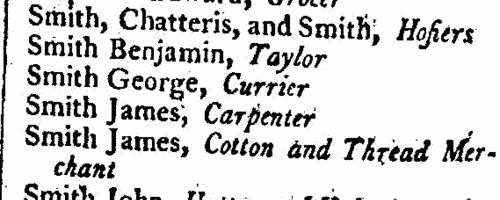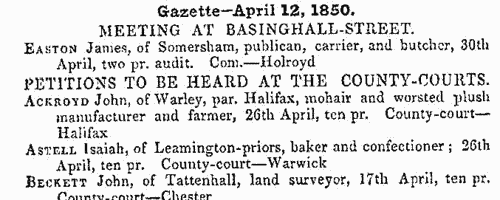Stokell Surname Ancestry ResultsOur indexes 1000-1999 include entries for the spelling 'stokell'. In the period you have requested, we have the following 24 records (displaying 1 to 10): Single Surname Subscription | | | Buying all 24 results of this search individually would cost £128.00. But you can have free access to all 24 records for a year, to view, to save and print, for £100. Save £28.00. More... |
These sample scans are from the original record. You will get scans of the full pages or articles where the surname you searched for has been found. Your web browser may prevent the sample windows from opening; in this case please change your browser settings to allow pop-up windows from this site.  Apprentices and articled clerks
(1765) Apprentices and articled clerks
(1765)
Apprenticeship indentures and clerks' articles were subject to a 6d or 12d per pound stamp duty (late payment of the 6d rate attracted double duty (D D) of 12d): the registers of the payments usually give the master's trade, address, and occupation, and the apprentice's name, as well as details of the date and length of the apprenticeship. 2 January to 31 December 1765.STOKELL. Cost: £8.00.  | Sample scan, click to enlarge

| Inhabitants of Newcastle upon Tyne in Northumberland
(1790-1797)
The provincial sections of the Universal British Directory include lists of gentry and traders from each town and the surrounding countryside, with names of local surgeons, lawyers, postmasters, carriers, &c. (the sample scan here is from the section for Nottingham). The directory started publication in 1791, but was not completed for some years, and the provincial lists, sent in by local agents, can date back as early as 1790 and as late as 1797.STOKELL. Cost: £6.00.  | Sample scan, click to enlarge

| South County Durham Poll Book: Barnard Castle District
(1832)
A poll for two Knights of the Shire to represent in Parliament the Southern Division of the county palatine of Durham was taken on 21 and 22 December 1832. This poll book sets out all the electors by polling district (Barnard Castle, Bishop Auckland, Darlington, Middleton-in-Teesdale, Sedgefield, Stanhope and Stockton) and gives registered number; full name (surname first); place of abode; nature of qualification (such as House as occupier, Land as occupier, Copyhold Property, &c.); and the name of the parish, township or place where the property is situate. The votes are set out in the right-hand columns, under P. (for Joseph Pearse, jun., esq.), B. (John Bowes, esq.), and S. (Robert Duncombe Shafto, esq.), the three candidates. A voter could choose two candidates, in which case a dash is put in each of the two appropriate columns, or plump for just one - where a star is placed in that candidate's column. This was the first election after the Reform Act, which extended the franchise in the counties to all adult men possessing freehold worth 40s a year or more, or copyhold or long leasehold of £10 or more, or being tenants or short leaseholders of £50 or more. STOKELL. Cost: £4.00.  | Sample scan, click to enlarge

| South County Durham Poll Book: Bishop Auckland District
(1832)
A poll for two Knights of the Shire to represent in Parliament the Southern Division of the county palatine of Durham was taken on 21 and 22 December 1832. This poll book sets out all the electors by polling district (Barnard Castle, Bishop Auckland, Darlington, Middleton-in-Teesdale, Sedgefield, Stanhope and Stockton) and gives registered number; full name (surname first); place of abode; nature of qualification (such as House as occupier, Land as occupier, Copyhold Property, &c.); and the name of the parish, township or place where the property is situate. The votes are set out in the right-hand columns, under P. (for Joseph Pearse, jun., esq.), B. (John Bowes, esq.), and S. (Robert Duncombe Shafto, esq.), the three candidates. A voter could choose two candidates, in which case a dash is put in each of the two appropriate columns, or plump for just one - where a star is placed in that candidate's column. This was the first election after the Reform Act, which extended the franchise in the counties to all adult men possessing freehold worth 40s a year or more, or copyhold or long leasehold of £10 or more, or being tenants or short leaseholders of £50 or more. STOKELL. Cost: £4.00.  | Sample scan, click to enlarge

| South County Durham Poll Book: Darlington District
(1832)
A poll for two Knights of the Shire to represent in Parliament the Southern Division of the county palatine of Durham was taken on 21 and 22 December 1832. This poll book sets out all the electors by polling district (Barnard Castle, Bishop Auckland, Darlington, Middleton-in-Teesdale, Sedgefield, Stanhope and Stockton) and gives registered number; full name (surname first); place of abode; nature of qualification (such as House as occupier, Land as occupier, Copyhold Property, &c.); and the name of the parish, township or place where the property is situate. The votes are set out in the right-hand columns, under P. (for Joseph Pearse, jun., esq.), B. (John Bowes, esq.), and S. (Robert Duncombe Shafto, esq.), the three candidates. A voter could choose two candidates, in which case a dash is put in each of the two appropriate columns, or plump for just one - where a star is placed in that candidate's column. This was the first election after the Reform Act, which extended the franchise in the counties to all adult men possessing freehold worth 40s a year or more, or copyhold or long leasehold of £10 or more, or being tenants or short leaseholders of £50 or more. STOKELL. Cost: £4.00.  | Sample scan, click to enlarge

| South County Durham Poll Book: Stockton District
(1832)
A poll for two Knights of the Shire to represent in Parliament the Southern Division of the county palatine of Durham was taken on 21 and 22 December 1832. This poll book sets out all the electors by polling district (Barnard Castle, Bishop Auckland, Darlington, Middleton-in-Teesdale, Sedgefield, Stanhope and Stockton) and gives registered number; full name (surname first); place of abode; nature of qualification (such as House as occupier, Land as occupier, Copyhold Property, &c.); and the name of the parish, township or place where the property is situate. The votes are set out in the right-hand columns, under P. (for Joseph Pearse, jun., esq.), B. (John Bowes, esq.), and S. (Robert Duncombe Shafto, esq.), the three candidates. A voter could choose two candidates, in which case a dash is put in each of the two appropriate columns, or plump for just one - where a star is placed in that candidate's column. This was the first election after the Reform Act, which extended the franchise in the counties to all adult men possessing freehold worth 40s a year or more, or copyhold or long leasehold of £10 or more, or being tenants or short leaseholders of £50 or more. STOKELL. Cost: £4.00.  | Sample scan, click to enlarge

|  British merchant seamen
(1835-1836) British merchant seamen
(1835-1836)
At this period, the foreign trade of ships plying to and from the British isles involved about 150,000 men on 15,000 ships; and the coasting trade about a quarter as many more. A large proportion of the seamen on these ships were British subjects, and so liable to be pressed for service in the Royal Navy; but there was no general register by which to identify them, so in 1835 parliament passed a Merchant Seamen's Registration Bill. Under this act this large register of British seamen was compiled, based on ships' crew lists gathered in British and Irish ports, and passed up to the registry in London. Each seaman was assigned a number, and the names were arranged in the register by first two letters of the surname (our sample scan shows one of the pages for 'Sm'); in addition, an attempt was made to separate out namesakes by giving the first instance of a name (a), the second (b), and so on. But no effective method was devised to prevent the same man being registered twice as he appeared in a second crew list; moreover, the original crew lists were clearly difficult for the registry clerks to copy, and some of the surname spellings appear to be corrupted. A parliamentary committee decided that the system devised did not answer the original problem, and this register was abandoned after less than two years: but it is an apparently comprehensive source for British merchant seamen in 1835 to 1836. The register records the number assigned to each man; his name; age; birthplace; quality (master, captain, mate, 2nd mate, mariner, seaman, fisherman, cook, carpenter, boy &c.); and the name and home port of his ship, with the date of the crew list (usually at the end of a voyage). Most of the men recorded were born in the British Isles, but not all (for instance, Charleston and Stockholm appear in the sample scan). The final column 'How disposed of' is rarely used, and indicates those instances where a man died, was discharged, or deserted his ship during the voyage.STOKELL. Cost: £8.00.  | Sample scan, click to enlarge

| Insolvents in England and Wales
(1847)
Perry's Bankrupt and Insolvent Gazette, issued monthly, included lists of insolvencies and stages in the process whereby the insolvents petitioned for release from debtors' prison. The insolvent is generally referred to by name (surname first), address and trade. This is the index to the names of the insolvents, from the issues from January to December 1847.STOKELL. Cost: £6.00.  | Sample scan, click to enlarge

| Bankrupts in England and Wales
(1849)
Perry's Bankrupt and Insolvent Gazette, issued monthly, included lists of bankruptcies and stages in the liquidation of the estate, payment of dividends, and discharge. The initial entry in this sequence gives the name of the bankrupt (surname first, in capitals), the date gazetted, address and trade (often with the phrase dlr. and ch., meaning dealer and chapman); the dates and times and courts of the official processes of surrender; the surname of the official commissioner (Com.); the surname of the official assignee; and the names and addresses of the solicitors; the date of the fiat; and whether on the bankrupt's own petition, or at the demand of petitioning creditors, whose names, trades and addresses are given. In subsequent entries the bankrupt is often merely referred to by name and trade. This is the index to the names of the bankrupts, from the issues from January to December 1849, which may or may not include the detailed first entry for any particular individual.STOKELL. Cost: £6.00.  | Sample scan, click to enlarge

| Insolvents in England and Wales
(1850)
Perry's Bankrupt and Insolvent Gazette, issued monthly, included lists of insolvencies and stages in the process whereby the insolvents petitioned for release from debtors' prison. The insolvent is generally referred to by name (surname first), address and trade. This is the index to the names of the insolvents, from the issues from January to December 1850.STOKELL. Cost: £6.00.  | Sample scan, click to enlarge

|
Research your ancestry, family history, genealogy and one-name study by direct access to original records and archives indexed by surname.
|













